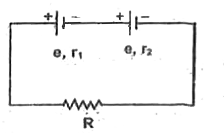Two wires of the same dimensions but resistivities ρ1 and ρ2 are connected in series. The equivalent resistivity of the combination is
ρ1+ρ22
ρ1+ρ2
2(ρ1+ρ2)
√ρ1ρ2
The correct Answer is:A
To find the equivalent resistivity of two wires of the same dimensions but different resistivities (ρ1 and ρ2) connected in series, we can follow these steps:
1. Understand the Setup: We have two wires of the same length L and cross-sectional area A. The resistivities of the wires are ρ1 and ρ2.
2. Calculate the Resistance of Each Wire:
- The resistance R1 of the first wire can be calculated using the formula:
R1=ρ1⋅LA
- The resistance R2 of the second wire is:
R2=ρ2⋅LA
3. Combine the Resistances: Since the two resistances are in series, the total or equivalent resistance R is given by:
R=R1+R2=ρ1⋅LA+ρ2⋅LA
4. Factor Out Common Terms: We can factor out LA from the equation:
R=LA(ρ1+ρ2)
5. Determine the Equivalent Resistivity: The equivalent resistivity ρ for the combination of the two wires can be defined as:
R=ρ⋅(2L)A
Here, the length of the combined wire is 2L because we have two wires in series.
6. Set the Two Expressions for Resistance Equal:
LA(ρ1+ρ2)=ρ⋅(2L)A
7. Solve for ρ:
- Cancel LA from both sides (assuming L and A are not zero):
ρ1+ρ2=2ρ
- Rearranging gives:
ρ=ρ1+ρ22
Final Answer:
The equivalent resistivity of the combination is:
ρ=ρ1+ρ22
- The resistance R1 of the first wire can be calculated using the formula:
R1=ρ1⋅LA
- The resistance R2 of the second wire is:
R2=ρ2⋅LA
R=R1+R2=ρ1⋅LA+ρ2⋅LA
R=LA(ρ1+ρ2)
R=ρ⋅(2L)A
Here, the length of the combined wire is 2L because we have two wires in series.
LA(ρ1+ρ2)=ρ⋅(2L)A
- Cancel LA from both sides (assuming L and A are not zero):
ρ1+ρ2=2ρ
- Rearranging gives:
ρ=ρ1+ρ22
The equivalent resistivity of the combination is:
ρ=ρ1+ρ22
Similar Questions
Knowledge Check
- Question 1 - Select One
Two resistors of resistances R1=(300±3)Ω and R2=(500±4)Ω are connected in series. The equivalent resistance of the series combination is
A(800±1)ΩB(800±7)ΩC(200±7)ΩD(200±1)Ω
The wires is of same dimension but resistivities ρ1 and ρ2 are connected in parallel . The equivalent resistivity of the combination is
View SolutionThe wire of same dimension but resistivities(p1) and (p2)are connected in parallel. The equivalent resistivity of the combination is
View SolutionThe equivalent resistance of the combination across AB is .
 View Solution
View SolutionTwo resistors of 2.092 and 3.0 22 are connected
in series. Find the effective resistance of combination .View SolutionThe resistance 4R,16R,64R....∞ are connected in series. Find their equivalent resistance.
View SolutionTwo cells of the same e.mf. e but different internal resistances r1andr2 are connected in series with an external resistance 'R'. The potential drop across the first cell is found to be zero. The external resistance Ris
 View Solution
View SolutionA piece of wire of resistance R is cut into five equal parts. These parts are then connected in parallel. If the equivalent resistance of this combination is R', then the ratio R/R' is :
View Solution

